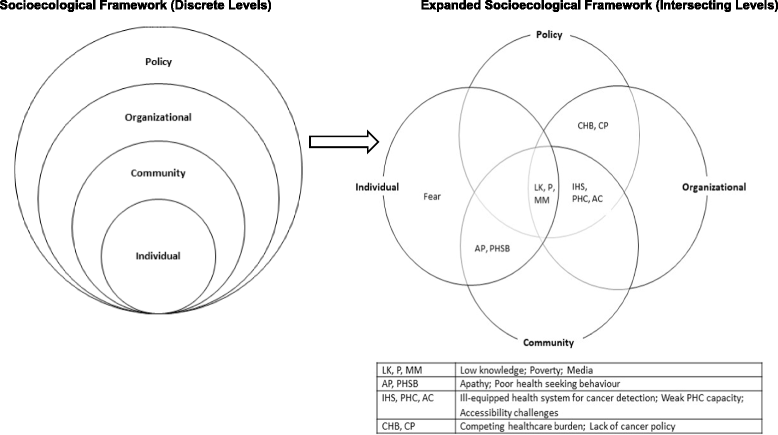Perceived barriers to early detection of breast cancer in Wakiso District, Uganda using a socioecological approach
- PMID: 29361954
- PMCID: PMC5781279
- DOI: 10.1186/s12992-018-0326-0
Perceived barriers to early detection of breast cancer in Wakiso District, Uganda using a socioecological approach
Abstract
Background: Early detection of breast cancer is known to improve its prognosis. However, women in most low and middle income countries, including Uganda, do not detect it early hence present at an advanced stage. This study investigated the perceived barriers to early detection of breast cancer in Wakiso district, Uganda using a multilevel approach focused through a socioecological framework.
Methods: Using qualitative methods, participants were purposively selected to take part in the study. 5 semi-structured interviews were conducted among the community members while two focus groups were conducted amongst women's group and community health workers (CHWs) in Ssisa sub county, Wakiso district. In addition, 7 key informant interviews with health professionals, policy makers and public health researchers were carried out.
Results: Findings from the study revealed that barriers to early detection of breast cancer are multifaceted and complex, cutting across individual, interpersonal, organizational, community and policy barriers. The major themes that emerged from the study included: knowledge, attitudes, beliefs and practices (KABP); health system and policy constraints; and structural barriers. Prominent barriers associated with KABP were low knowledge, apathy, fear and poor health seeking behaviours. Barriers within the health systems and policy arenas were mostly centred around competing health care burdens within the country, lack of a cancer policy and weak primary health care capacity in Wakiso district. Distance, poverty and limited access to media were identified as the most prominent structural barriers.
Conclusion: Barriers to early detection of breast cancer are complex and go beyond individual behaviours. These barriers interact across multiple levels of influence such as organizational, community and policy. The findings of this study could provide opportunities for investment in multi-level interventions.
Keywords: Barriers; Breast cancer; Early detection; Socioecological framework; Uganda.
Conflict of interest statement
Ethics approval and consent to participate
Ethics approval was obtained in compliance with ethical standards for research involving human participants. Approval was obtained from of Nottingham Trent University School of Social Sciences Ethical Committee (Reference number: 130,315) and Makerere University School of Public Health Higher Degrees, Research and Ethics Committee and Uganda National Council for Science and Technology (UNCST) (Reference number 260315) as part of the community health workers project. Informed consent was obtained from all study participants in compliance with the ethical approval.
Consent for publication
Not applicable
Competing interests
The authors declare that they have no competing interests.
Publisher’s Note
Springer Nature remains neutral with regard to jurisdictional claims in published maps and institutional affiliations.
Figures
Similar articles
-
Integrated community case management in a peri-urban setting: a qualitative evaluation in Wakiso District, Uganda.BMC Health Serv Res. 2017 Nov 28;17(1):785. doi: 10.1186/s12913-017-2723-0. BMC Health Serv Res. 2017. PMID: 29183312 Free PMC article.
-
Understanding implementation barriers in the national scale-up of differentiated ART delivery in Uganda.BMC Health Serv Res. 2020 Mar 17;20(1):222. doi: 10.1186/s12913-020-5069-y. BMC Health Serv Res. 2020. PMID: 32183796 Free PMC article.
-
Linking communities to formal health care providers through village health teams in rural Uganda: lessons from linking social capital.Hum Resour Health. 2017 Jan 11;15(1):4. doi: 10.1186/s12960-016-0177-9. Hum Resour Health. 2017. PMID: 28077148 Free PMC article.
-
Drivers of cervical cancer prevention and management in sub-Saharan Africa: a qualitative synthesis of mixed studies.Health Res Policy Syst. 2024 Feb 8;22(1):21. doi: 10.1186/s12961-023-01094-3. Health Res Policy Syst. 2024. PMID: 38331830 Free PMC article. Review.
-
The influence of Malay cultural beliefs on breast cancer screening and genetic testing: A focus group study.Psychooncology. 2018 Dec;27(12):2855-2861. doi: 10.1002/pon.4902. Epub 2018 Oct 16. Psychooncology. 2018. PMID: 30264524 Review.
Cited by
-
"Some They Need Male, Some They Need Female": A Gendered Approach for Breast Cancer Detection in Uganda.Front Glob Womens Health. 2022 Mar 25;3:746498. doi: 10.3389/fgwh.2022.746498. eCollection 2022. Front Glob Womens Health. 2022. PMID: 35400129 Free PMC article.
-
Multi-level barriers to early detection of breast cancer among rural midlife women in Tanzania: A qualitative case study.PLoS One. 2024 Feb 29;19(2):e0297798. doi: 10.1371/journal.pone.0297798. eCollection 2024. PLoS One. 2024. PMID: 38422068 Free PMC article.
-
Development of a Culturally Appropriate Text Messaging Platform for Improving Breast Cancer Screening Uptake Among Ghanaian Women in Metropolitan Areas.Int J Breast Cancer. 2024 Oct 24;2024:5587515. doi: 10.1155/2024/5587515. eCollection 2024. Int J Breast Cancer. 2024. PMID: 39483925 Free PMC article.
-
Breast cancer knowledge among health professionals: A pre-post-knowledge-based intervention study.J Family Med Prim Care. 2022 Sep;11(9):5649-5655. doi: 10.4103/jfmpc.jfmpc_1226_22. Epub 2022 Oct 14. J Family Med Prim Care. 2022. PMID: 36505641 Free PMC article.
-
Awareness of lung cancer among urban residents in Sichuan Province and its impact on their willingness to choose medical institutions for cancer screening.Front Public Health. 2025 Jan 7;12:1388140. doi: 10.3389/fpubh.2024.1388140. eCollection 2024. Front Public Health. 2025. PMID: 39850860 Free PMC article.
References
-
- Ferlay J, Soerjomataram I, Ervik M, Dikshit R, Eser S, Mathers C, Rebelo M, Parkin DM, Forman D, Bray F. GLOBOCAN 2012 v1.0, cancer incidence and mortality worldwide: IARC CancerBase no. 11 [internet] Lyon, France: International Agency for Research on Cancer [Online]; 2013.
Publication types
MeSH terms
LinkOut - more resources
Full Text Sources
Other Literature Sources
Medical


